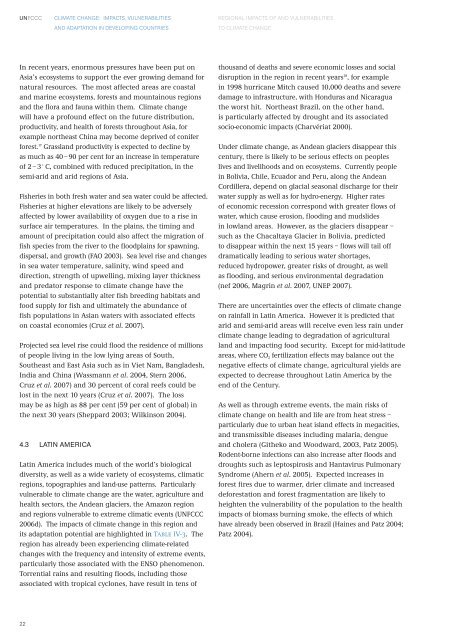impacts
You also want an ePaper? Increase the reach of your titles
YUMPU automatically turns print PDFs into web optimized ePapers that Google loves.
UNFCCC<br />
CLIMATE CHANGE: IMPACTS, VULNERABILITIES<br />
AND ADAPTATION IN DEVELOPING COUNTRIES<br />
REGIONAL IMPACTS OF AND VULNERABILITIES<br />
TO CLIMATE CHANGE<br />
In recent years, enormous pressures have been put on<br />
Asia’s ecosystems to support the ever growing demand for<br />
natural resources. The most affected areas are coastal<br />
and marine ecosystems, forests and mountainous regions<br />
and the flora and fauna within them. Climate change<br />
will have a profound effect on the future distribution,<br />
productivity, and health of forests throughout Asia, for<br />
example northeast China may become deprived of conifer<br />
forest. 17 Grassland productivity is expected to decline by<br />
as much as 40 – 90 per cent for an increase in temperature<br />
of 2 – 3° C, combined with reduced precipitation, in the<br />
semi-arid and arid regions of Asia.<br />
Fisheries in both fresh water and sea water could be affected.<br />
Fisheries at higher elevations are likely to be adversely<br />
affected by lower availability of oxygen due to a rise in<br />
surface air temperatures. In the plains, the timing and<br />
amount of precipitation could also affect the migration of<br />
fish species from the river to the floodplains for spawning,<br />
dispersal, and growth (FAO 2003). Sea level rise and changes<br />
in sea water temperature, salinity, wind speed and<br />
direction, strength of upwelling, mixing layer thickness<br />
and predator response to climate change have the<br />
potential to substantially alter fish breeding habitats and<br />
food supply for fish and ultimately the abundance of<br />
fish populations in Asian waters with associated effects<br />
on coastal economies (Cruz et al. 2007).<br />
Projected sea level rise could flood the residence of millions<br />
of people living in the low lying areas of South,<br />
Southeast and East Asia such as in Viet Nam, Bangladesh,<br />
India and China (Wassmann et al. 2004, Stern 2006,<br />
Cruz et al. 2007) and 30 percent of coral reefs could be<br />
lost in the next 10 years (Cruz et al. 2007). The loss<br />
may be as high as 88 per cent (59 per cent of global) in<br />
the next 30 years (Sheppard 2003; Wilkinson 2004).<br />
4.3 LATIN AMERICA<br />
Latin America includes much of the world’s biological<br />
diversity, as well as a wide variety of ecosystems, climatic<br />
regions, topographies and land-use patterns. Particularly<br />
vulnerable to climate change are the water, agriculture and<br />
health sectors, the Andean glaciers, the Amazon region<br />
and regions vulnerable to extreme climatic events (UNFCCC<br />
2006d). The <strong>impacts</strong> of climate change in this region and<br />
its adaptation potential are highlighted in Table IV-3. The<br />
region has already been experiencing climate-related<br />
changes with the frequency and intensity of extreme events,<br />
particularly those associated with the ENSO phenomenon.<br />
Torrential rains and resulting floods, including those<br />
associated with tropical cyclones, have result in tens of<br />
thousand of deaths and severe economic losses and social<br />
disruption in the region in recent years 18 , for example<br />
in 1998 hurricane Mitch caused 10,000 deaths and severe<br />
damage to infrastructure, with Honduras and Nicaragua<br />
the worst hit. Northeast Brazil, on the other hand,<br />
is particularly affected by drought and its associated<br />
socio-economic <strong>impacts</strong> (Charvériat 2000).<br />
Under climate change, as Andean glaciers disappear this<br />
century, there is likely to be serious effects on peoples<br />
lives and livelihoods and on ecosystems. Currently people<br />
in Bolivia, Chile, Ecuador and Peru, along the Andean<br />
Cordillera, depend on glacial seasonal discharge for their<br />
water supply as well as for hydro-energy. Higher rates<br />
of economic recession correspond with greater flows of<br />
water, which cause erosion, flooding and mudslides<br />
in lowland areas. However, as the glaciers disappear –<br />
such as the Chacaltaya Glacier in Bolivia, predicted<br />
to disappear within the next 15 years – flows will tail off<br />
dramatically leading to serious water shortages,<br />
reduced hydropower, greater risks of drought, as well<br />
as flooding, and serious environmental degradation<br />
(nef 2006, Magrin et al. 2007, UNEP 2007).<br />
There are uncertainties over the effects of climate change<br />
on rainfall in Latin America. However it is predicted that<br />
arid and semi-arid areas will receive even less rain under<br />
climate change leading to degradation of agricultural<br />
land and impacting food security. Except for mid-latitude<br />
areas, where CO 2 fertilization effects may balance out the<br />
negative effects of climate change, agricultural yields are<br />
expected to decrease throughout Latin America by the<br />
end of the Century.<br />
As well as through extreme events, the main risks of<br />
climate change on health and life are from heat stress –<br />
particularly due to urban heat island effects in megacities,<br />
and transmissible diseases including malaria, dengue<br />
and cholera (Githeko and Woodward, 2003, Patz 2005).<br />
Rodent-borne infections can also increase after floods and<br />
droughts such as leptospirosis and Hantavirus Pulmonary<br />
Syndrome (Ahern et al. 2005). Expected increases in<br />
forest fires due to warmer, drier climate and increased<br />
deforestation and forest fragmentation are likely to<br />
heighten the vulnerability of the population to the health<br />
<strong>impacts</strong> of biomass burning smoke, the effects of which<br />
have already been observed in Brazil (Haines and Patz 2004;<br />
Patz 2004).<br />
22


